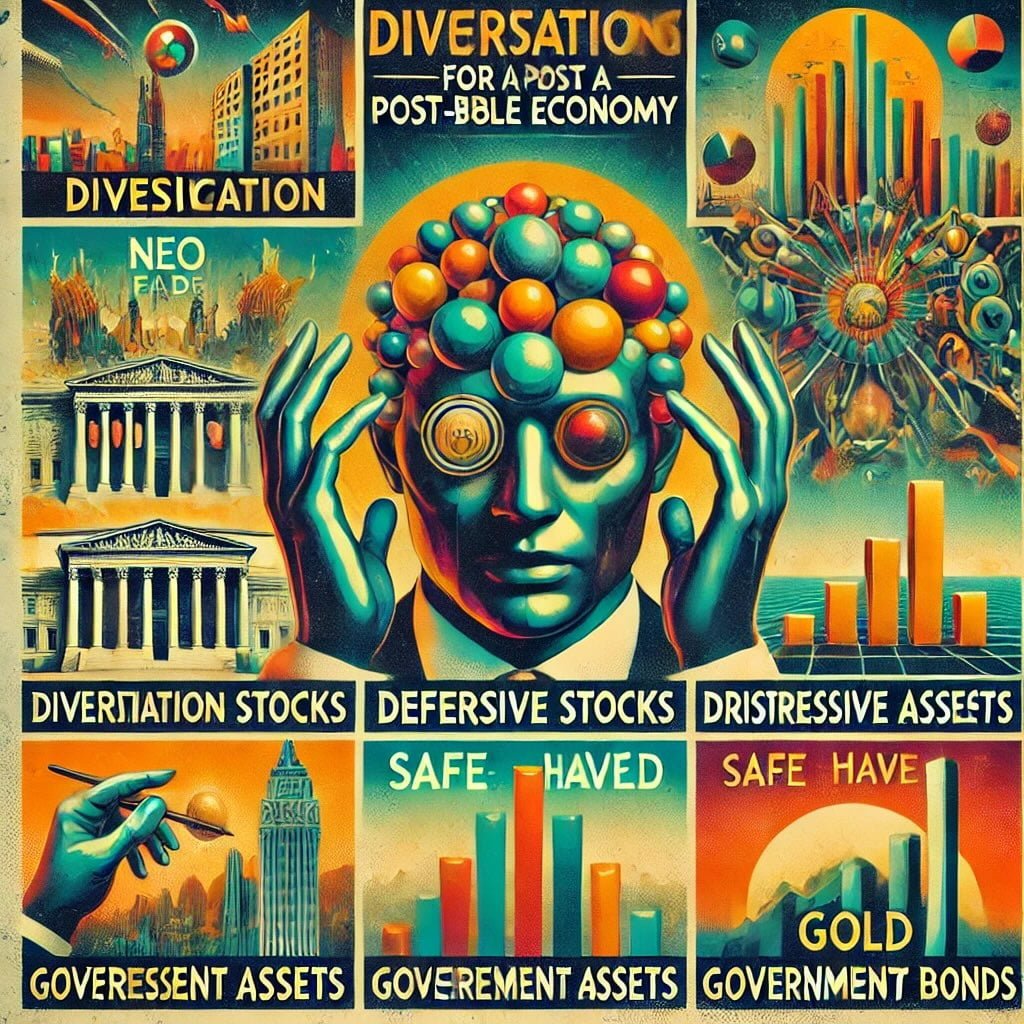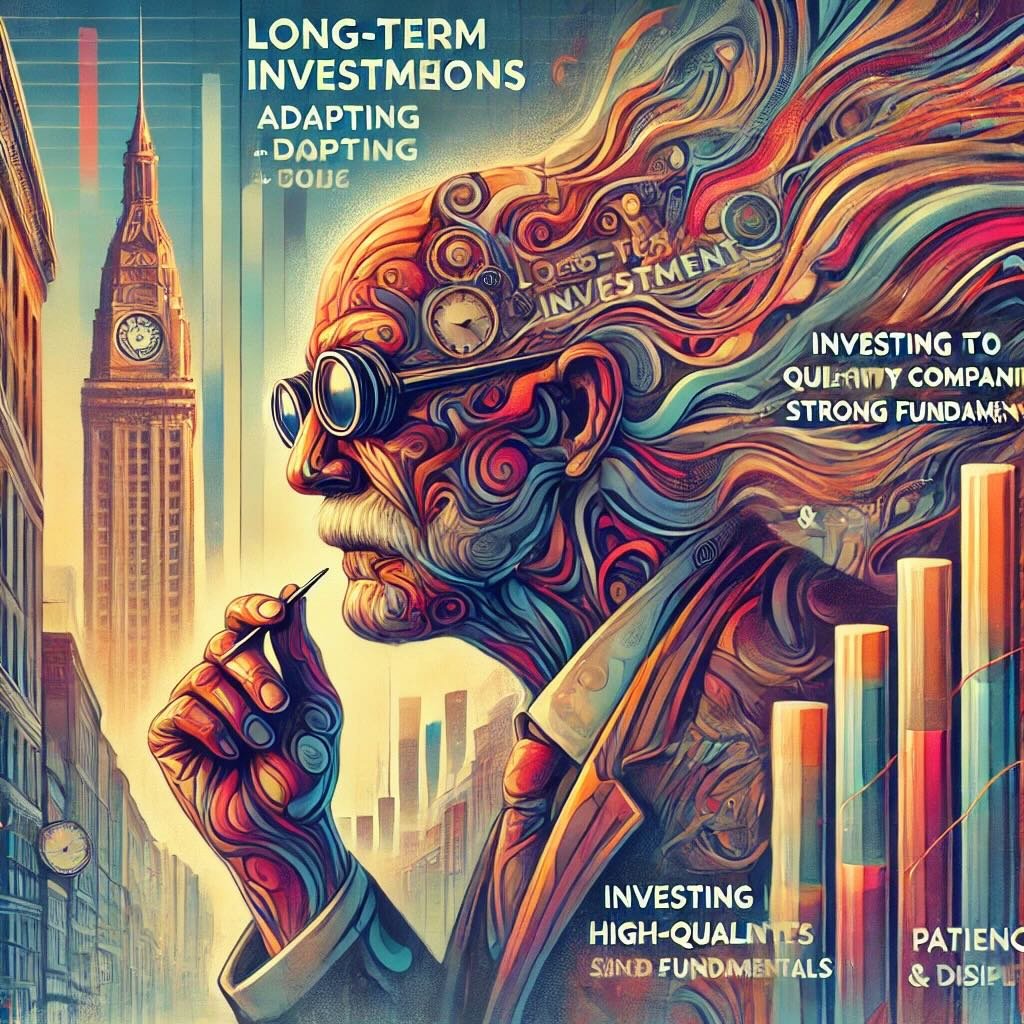A housing bubble occurs when property prices rise rapidly due to high demand, speculation, and exuberant spending. These inflated prices eventually reach unsustainable levels, leading to a sharp decline or “burst” when market confidence wanes. Historical examples include the U.S. housing bubble of the mid-2000s, which culminated in the 2008 financial crisis, and Japan’s real estate bubble in the late 1980s, followed by a decade of economic stagnation.
source: The Canadian Shield on YouTube
Overview of the Housing Bubble
We’ll equip investors with practical strategies for navigating the economic landscape after a housing bubble has burst. With markets often experiencing significant volatility and uncertainty during these periods, it’s essential to approach investments with a well-considered plan tailored to the unique challenges of a post-bubble economy.

Importance of Strategic Planning
The aftermath of a housing bubble can leave markets in disarray, with falling property values, increased debt burdens, and shifts in consumer behavior. For investors, this environment presents both risks and opportunities. Strategic planning becomes critical to safeguard assets, capitalize on undervalued investments, and adjust portfolios to align with new economic realities. By adapting investment strategies, investors can better manage risks and position themselves for long-term growth, even in the face of economic uncertainty.

Understanding the Post-Bubble Economic Landscape
Economic Consequences of a Housing Bubble Burst
When a housing bubble bursts, the economic repercussions can be severe and far-reaching. Typically, one of the first casualties is the overall economy slipping into a recession. This downturn isn’t just a slight dip; it’s often characterized by significant declines in economic output, leading to a rise in unemployment as businesses cut costs to stay afloat. As jobs become scarcer, consumer confidence takes a nosedive, further exacerbating the economic slowdown.
But the impact doesn’t stop there. The ripple effects of a housing bubble burst spread far and wide, touching other financial markets as well:
- Stock Market: Often experiences sharp declines as investors rush to sell off assets, fearing further losses.
- Bonds: Traditionally seen as safer investments, might see fluctuating yields as the demand for stability increases.
- Commodities: Prices can swing wildly as the market tries to find its footing amidst the chaos.
Market Volatility and Uncertainty
Following the burst of a housing bubble, the market enters a period of heightened volatility and uncertainty. Investors find themselves on edge, unsure of where the market will move next. The days of steady growth are replaced by a rollercoaster of ups and downs, making it difficult for even seasoned investors to predict outcomes.
During this time, investor sentiment shifts dramatically:
- Optimism fades: Replaced by fear and caution.
- Erratic behavior: Panic selling, sudden buying sprees, and abrupt changes in investment strategies become common.
The market behaves almost like a living organism, reacting to every piece of news, whether good or bad, with exaggerated movements.
Government and Central Bank Interventions
In response to the economic turmoil, governments and central banks often step in with a series of interventions designed to stabilize the situation. These interventions typically include:
- Interest Rate Cuts: Lowering rates to make borrowing cheaper, encouraging spending and investment to kickstart the economy.
- Stimulus Packages: Direct financial aid to individuals and businesses, or large-scale public works projects aimed at creating jobs and boosting economic activity.
- Regulatory Changes: Tightening rules to prevent the same mistakes that led to the bubble from happening again.
These interventions, while often necessary, have a profound impact on the investment landscape:
- New Opportunities: Lower interest rates might make stocks more attractive compared to bonds, driving up equity prices.
- New Risks: They can also lead to asset bubbles in other areas, as cheap money fuels speculation.

Investment Strategies for a Post-Bubble Economy
In a post-bubble economy, diversification becomes more than just a buzzword—it’s a necessity. Spreading your investments across various asset classes, like stocks, bonds, real estate, and commodities, can be a game-changer. Why? Because when one asset class takes a hit, others might remain stable or even thrive. This balance helps in mitigating risk and stabilizing returns, especially when the economy is on the mend. It’s like having different gears in a car—when one struggles, the others can keep things moving.
Focus on Defensive Stocks and Sectors
When the economy turns sour, not all sectors suffer equally. Defensive stocks, particularly in sectors like consumer staples, utilities, and healthcare, often hold their ground. These industries provide essential services that people rely on regardless of economic conditions. Investing in these areas can be a smart move. They tend to offer stability and, better yet, steady dividends, making them a safe harbor in stormy economic seas.
Opportunities in Distressed Assets
Economic downturns often lead to distressed assets—real estate, stocks, and bonds that have plummeted in value. For the savvy investor, this can spell opportunity. Buying undervalued or foreclosed properties, for instance, can yield significant returns when the market recovers. But let’s be clear: this strategy isn’t without its risks. It’s a high-stakes game that requires careful analysis and a strong stomach, but the rewards can be worth it if played wisely.
Investing in Government Bonds and Treasuries
When markets are volatile, safety becomes a priority. That’s where government bonds and treasuries come into play. These are considered safe-haven investments, providing steady income and preserving capital even when everything else seems shaky. They might not offer the highest returns, but their stability is unmatched in uncertain times, making them a cornerstone for a conservative post-bubble portfolio.
Gold and Precious Metals
Gold has long been seen as a refuge during times of economic distress. When inflation rises or currencies devalue, gold and other precious metals often shine. These assets act as a hedge, protecting wealth when other investments falter. During economic downturns and the subsequent recovery phase, they can provide a sense of security, making them a valuable addition to your investment strategy.
Emerging Market Opportunities
While developed markets might be reeling from the effects of a housing bubble, emerging markets can present intriguing opportunities. These markets often operate under different economic conditions and might be less affected by the bubble’s burst. However, investing here isn’t without its challenges. The risks can be higher due to political instability or less mature financial systems, but for those willing to take the leap, the rewards can be substantial during a global economic downturn.

Real Estate Investment Strategies Post-Bubble
In the aftermath of a housing bubble, the real estate market is often filled with opportunities—if you know where to look. Identifying undervalued properties is key to making smart investments with strong long-term potential. But how do you spot these gems? It all starts with thorough market research. Understanding the local market trends, property values, and future development plans can give you an edge.
Location, location, location—you’ve heard it before, and it holds true, especially in a post-bubble scenario. Properties in areas poised for growth or undergoing revitalization are often undervalued but have significant upside. Timing is also crucial. Jumping in too early can be risky, but waiting too long might mean missing out on the best deals. It’s all about finding that sweet spot.
Real Estate Investment Trusts (REITs)
If diving into property ownership directly feels daunting, Real Estate Investment Trusts (REITs) offer an appealing alternative. Investing in REITs allows you to gain exposure to the real estate market without the headaches of managing physical properties. They’re like a mutual fund but for real estate, pooling together capital from numerous investors to purchase and manage income-generating properties.
In a post-bubble economy, certain types of REITs can perform particularly well. Commercial REITs, which invest in office buildings, shopping centers, and other commercial spaces, might offer stability as businesses seek reliable locations during recovery. Healthcare REITs are another strong contender, as they invest in properties like hospitals, nursing facilities, and medical offices—sectors that tend to remain robust even during economic downturns.
Focus on Rental Income
In a declining property market, focusing on rental income and cash flow becomes more important than ever. Rather than banking on property appreciation, smart investors look to maximize the income their properties generate. This means paying close attention to tenant demand and maintaining occupancy rates.
During economic recovery, rental income can be a lifeline. Strategies to maintain and increase this income include upgrading properties to attract higher-paying tenants, offering flexible lease terms, and ensuring top-notch property management. By focusing on steady cash flow, you can weather the storm of a post-bubble economy and position yourself for growth as the market stabilizes.

Risk Management and Portfolio Protection
Implementing Stop-Loss Orders
In a volatile market, safeguarding your investments becomes paramount. One effective way to do this is by implementing stop-loss orders. A stop-loss order is essentially a safety net—it automatically sells your investment if the price drops to a predetermined level, protecting you from significant losses. But how do you set these levels?
Setting appropriate stop-loss levels requires a keen understanding of both your investment goals and the market’s current behavior. In a post-bubble environment, where price swings can be unpredictable, it’s crucial to strike a balance. Set your stop-loss too tight, and you might exit a position prematurely during a temporary dip. Set it too loose, and you risk holding onto a losing investment for too long. It’s about finding that sweet spot where you protect your downside without unnecessarily limiting your upside.
Maintaining Liquidity
Liquidity is the lifeblood of any investment portfolio, especially in turbulent times. Maintaining liquidity—having cash or easily sellable assets on hand—gives you the flexibility to seize market opportunities as they arise and manage risks more effectively. But there’s a balancing act here too.
While liquidity is vital, you don’t want to hold too much in cash, as it may underperform compared to long-term investments. The key is to find a balance that suits your risk tolerance and investment goals. Think of liquidity as your financial cushion—enough to keep you secure, but not so much that it hampers your growth potential.
Hedging Strategies
When markets become unpredictable, hedging can be a valuable strategy to protect your portfolio. Hedging involves using financial instruments like options, futures, and inverse ETFs to offset potential losses in other investments. These strategies can act as insurance, providing peace of mind during market downturns.
However, hedging comes with its own set of costs and complexities. Options and futures, for example, can require a level of expertise and involve additional fees. Inverse ETFs might help protect against market declines, but they also carry the risk of underperformance if the market moves against your position. In a post-bubble environment, where market conditions are anything but stable, the potential benefits of hedging might outweigh the costs—but it’s crucial to understand the tools you’re using and how they fit into your overall strategy.

Long-Term Investment Considerations
Adapting to Economic Shifts
In the ever-evolving landscape of a post-bubble economy, adaptability is key. Staying informed and being willing to adjust your investment strategies as economic conditions change is crucial for long-term success. The economy doesn’t stay static; it shifts, sometimes subtly, other times dramatically. As an investor, you need to be agile, ready to pivot when necessary.
Long-term shifts in the economy, like changes in consumer behavior, technological advancements, or shifts in global trade, can have profound impacts on investment decisions. Being aware of these trends and understanding their potential effects on different sectors will help you position your portfolio for the future. It’s not just about reacting to changes; it’s about anticipating them.
Focusing on Quality and Fundamentals
When navigating uncertain economic waters, quality becomes your anchor. Investing in high-quality companies with strong fundamentals is a strategy that can withstand the test of time. These are companies with solid balance sheets, strong cash flows, and a proven track record of weathering economic storms.
But how do you identify such companies? Look for businesses with a competitive advantage, whether it’s a unique product, strong brand, or efficient operations. Companies that consistently deliver value to their customers and shareholders are more likely to thrive during recovery periods. In a post-bubble economy, focusing on quality isn’t just a good idea—it’s essential.
Patience and Discipline
Investing in a post-bubble economy requires more than just a good strategy; it demands patience and discipline. The market can be volatile, with sharp ups and downs that test even the most seasoned investors. But remember, investing is a marathon, not a sprint.
Maintaining a long-term investment horizon can help you ride out short-term volatility. It’s about keeping your eyes on the prize and not getting swayed by the noise. Patience allows you to let your investments grow over time, while discipline ensures that you stick to your strategy, even when the market gets rocky. In the end, these qualities can make all the difference between a successful investment journey and one fraught with unnecessary stress.
12-Question FAQ: Investment Strategies for a Post-Housing Bubble Economy
1) What happens to the economy after a housing bubble bursts?
Recessions are common: credit tightens, unemployment rises, asset prices re-rate, and confidence falls. Policy makers often respond with rate cuts, liquidity programs, and fiscal stimulus—creating new risks and opportunities.
2) What high-level strategy should investors prioritize first?
A written plan: objectives, time horizon, risk limits, target asset mix, rebalancing rules, and cash reserves. In chaotic markets, process beats prediction.
3) How should I diversify in a post-bubble environment?
Use multi-asset diversification: domestic & international equities, quality bonds (gov’t/IG), cash/short duration, real assets (REITs/commodities), and—when appropriate—alternatives with true low correlation.
4) Which equity styles/sectors tend to be more resilient?
Defensive, cash-generative names: consumer staples, utilities, healthcare, some telecoms; quality factor (high ROIC, strong balance sheets), dividend growers, and low-volatility ETFs.
5) Where are the contrarian opportunities?
Distressed/discounted assets: selective real estate, recapitalizations, busted converts, high-yield credits with improving coverage, and quality cyclicals mispriced by forced selling—provided you use rigorous credit/equity underwriting.
6) What fixed-income exposures make sense?
Core is sovereign/agency and high-grade corporates for ballast; add short duration for rate risk control. Opportunistically ladder maturities or use target-maturity ETFs. Be selective with high yield/emerging debt.
7) Should I hold gold or commodities?
A measured allocation to gold/precious metals can hedge policy error, inflation, and currency weakness. Broad commodities are cyclical; size modestly and understand roll costs/term structure.
8) How can I approach real estate post-bubble?
Focus on cash flow over appreciation: positive cap rates, strong tenant demand, conservative LTV. Consider REITs for liquidity/diversification (e.g., logistics, data centers, healthcare) and avoid over-levered niches.
9) What risk controls are most useful now?
Position sizing & max drawdown limits
Stop-loss/stop-limit where appropriate
Rebalancing bands (e.g., ±5%)
Maintain liquidity (6–12 months’ needs)
Hedging (index puts, collars, inverse/low-beta overlays) used sparingly and knowingly
10) How do I deploy capital without trying to “call the bottom”?
Stage entries with dollar-cost averaging, add on dislocations via value-averaging or buy-the-dip rules tied to valuation/credit spreads, and rebalance systematically.
11) What common mistakes should I avoid?
Catching falling knives without a thesis, chasing yield/leverage, ignoring refinancing walls, over-concentrating in one geography or sector, and abandoning plans due to headline noise.
12) What’s the long-term mindset for recovery phases?
Prioritize quality & cash generation, tax efficiency, and patience. Let compounding work; review quarterly, change slowly, and keep dry powder for fat-pitch opportunities.
Educational only—not investment, legal, or tax advice.

Conclusion
Navigating a post-housing bubble economy requires a well-thought-out approach. We’ve covered several key strategies to help you steer through these uncertain waters. Diversifying across asset classes, focusing on defensive stocks, and exploring opportunities in distressed assets can provide a solid foundation. Don’t overlook the benefits of investing in REITs, maintaining liquidity, or implementing hedging strategies to protect your portfolio. Each of these tactics plays a crucial role in managing risk and positioning yourself for potential gains as the market stabilizes.
Encouragement to Stay Informed and Flexible
The economic landscape is anything but static. It shifts, evolves, and sometimes throws curveballs when least expected. That’s why it’s essential to stay informed and remain flexible in your approach. Keep an eye on market trends, economic indicators, and global events that could impact your investments. Flexibility isn’t just about reacting to changes—it’s about anticipating them and being prepared to adjust your strategy as needed. Staying proactive and informed will give you an edge in a dynamic market.
Final Thoughts on Navigating a Post-Bubble Economy
Investing in a post-bubble economy presents both challenges and opportunities. The road ahead might be bumpy, but with strategic planning and diligent risk management, you can navigate these challenges effectively. Remember, it’s not just about weathering the storm—it’s about finding opportunities to thrive in its aftermath. By staying disciplined, focusing on quality investments, and keeping a long-term perspective, you can turn potential risks into rewards. The key is to stay vigilant, stay informed, and always be ready to adapt to whatever the market throws your way.
Important Information
Comprehensive Investment Disclaimer:
All content provided on this website (including but not limited to portfolio ideas, fund analyses, investment strategies, commentary on market conditions, and discussions regarding leverage) is strictly for educational, informational, and illustrative purposes only. The information does not constitute financial, investment, tax, accounting, or legal advice. Opinions, strategies, and ideas presented herein represent personal perspectives, are based on independent research and publicly available information, and do not necessarily reflect the views or official positions of any third-party organizations, institutions, or affiliates.
Investing in financial markets inherently carries substantial risks, including but not limited to market volatility, economic uncertainties, geopolitical developments, and liquidity risks. You must be fully aware that there is always the potential for partial or total loss of your principal investment. Additionally, the use of leverage or leveraged financial products significantly increases risk exposure by amplifying both potential gains and potential losses, and thus is not appropriate or advisable for all investors. Using leverage may result in losing more than your initial invested capital, incurring margin calls, experiencing substantial interest costs, or suffering severe financial distress.
Past performance indicators, including historical data, backtesting results, and hypothetical scenarios, should never be viewed as guarantees or reliable predictions of future performance. Any examples provided are purely hypothetical and intended only for illustration purposes. Performance benchmarks, such as market indexes mentioned on this site, are theoretical and are not directly investable. While diligent efforts are made to provide accurate and current information, “Picture Perfect Portfolios” does not warrant, represent, or guarantee the accuracy, completeness, or timeliness of any information provided. Errors, inaccuracies, or outdated information may exist.
Users of this website are strongly encouraged to independently verify all information, conduct comprehensive research and due diligence, and engage with qualified financial, investment, tax, or legal professionals before making any investment or financial decisions. The responsibility for making informed investment decisions rests entirely with the individual. “Picture Perfect Portfolios” explicitly disclaims all liability for any direct, indirect, incidental, special, consequential, or other losses or damages incurred, financial or otherwise, arising out of reliance upon, or use of, any content or information presented on this website.
By accessing, reading, and utilizing the content on this website, you expressly acknowledge, understand, accept, and agree to abide by these terms and conditions. Please consult the full and detailed disclaimer available elsewhere on this website for further clarification and additional important disclosures. Read the complete disclaimer here.




